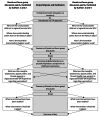What happens at two? Immunisation stakeholders' perspectives on factors influencing sub-optimal childhood vaccine uptake for toddlers in regional and remote Western Australia
- PMID: 39175040
- PMCID: PMC11340031
- DOI: 10.1186/s12913-024-11371-8
What happens at two? Immunisation stakeholders' perspectives on factors influencing sub-optimal childhood vaccine uptake for toddlers in regional and remote Western Australia
Abstract
Background: In Western Australia (WA), children aged 24 months living regionally or remotely (non-urban) have suboptimal vaccine uptake. As there has not yet been a systematic approach to understanding the facilitators and barriers to childhood vaccination in regional and remote WA, this study aimed to understand the views of key immunisation stakeholders regarding barriers and solutions.
Methods: Drawing on the World Health Organization's "Tailoring Immunization Programmes" approach, we undertook a qualitative study with three forms of data collection: (1) semi-structured interviews with immunisation experts within Australia's immunisation system, (2) a semi-structured focus group with immunisation coordinators and health workers working in regional or remote WA, and (3) member checking with senior staff from WA Health. Data from the interviews and focus group was deductively analysed using the Capability-Opportunity-Motivation-Behaviour (COM-B) model on NVivo 20.
Results: There was no clear consensus on the typical under-vaccinated child in country WA. A range of barriers were identified: lack of awareness of the vaccine schedule, difficult access to vaccination services, a shortage in a workforce able to have meaningful conversations with vaccine hesitant parents, ineffective reminder systems, and the rapid spread of misinformation. Participants described previous efforts used to improve vaccine uptake, and felt the following would improve uptake: better access to vaccine clinics, building capacity of Aboriginal Health Workers, and vaccine reminders.
Conclusion: This is the first time the facilitators and barriers to routine childhood vaccine uptake in country WA has been explored. Addressing some of these barriers may see an increase in uptake.
Keywords: Children; Focus groups; Health behavior; Rural health services; Vaccination.
© 2024. The Author(s).
Conflict of interest statement
Katie Attwell is a specialist advisor to the Australian Technical Advisory Group on Immunisation. She is a past recipient of a Discovery Early Career Researcher Award funded by the Australian Research Council of the Australian Government (DE19000158). She leads the “Coronavax” project, which is funded by the Government of Western Australia. She leads “MandEval: Effectiveness and Consequences of Australia’s COVID-19 Vaccine Mandates”, a new project funded by the Medical Research Future Fund of the Australian Government (2019107). All funds were paid to her institution. Funders are not involved in the conceptualization, design, data collection, analysis, decision to publish, or preparation of manuscripts. The other authors have nothing to declare.
Figures
References
-
- European Centre for Disease Prevention and Control. Epidemiological update: measles - monitoring European outbreaks. Stockholm: European Centre for Disease Prevention and Control; 2017.
-
- Dey A, Wang H, Beard F, Macartney K, McIntyre P. Summary of national surveillance data on vaccine preventable diseases in Australia, 2012–2015. Commun Dis Intell. 2019;43. - PubMed
-
- Department of Health. Annual report 2019-20: Government of Western Australia. https://ww2.health.wa.gov.au/~/media/Corp/Documents/Reports-and-publicat... (2020). Accessed 20 Feb 2022.
-
- Australian Government Department of Health. Childhood vaccination coverage. https://www.health.gov.au/topics/immunisation/immunisation-data/childhoo... (2020). Accessed 13 May 2022.
-
- O’Brien ED, Sam GA, Mead C. Methodology for measuring Australia’s childhood immunisation coverage. Commun Dis Intell. 1998;22(3):36–7. - PubMed
MeSH terms
Grants and funding
LinkOut - more resources
Full Text Sources
Research Materials


